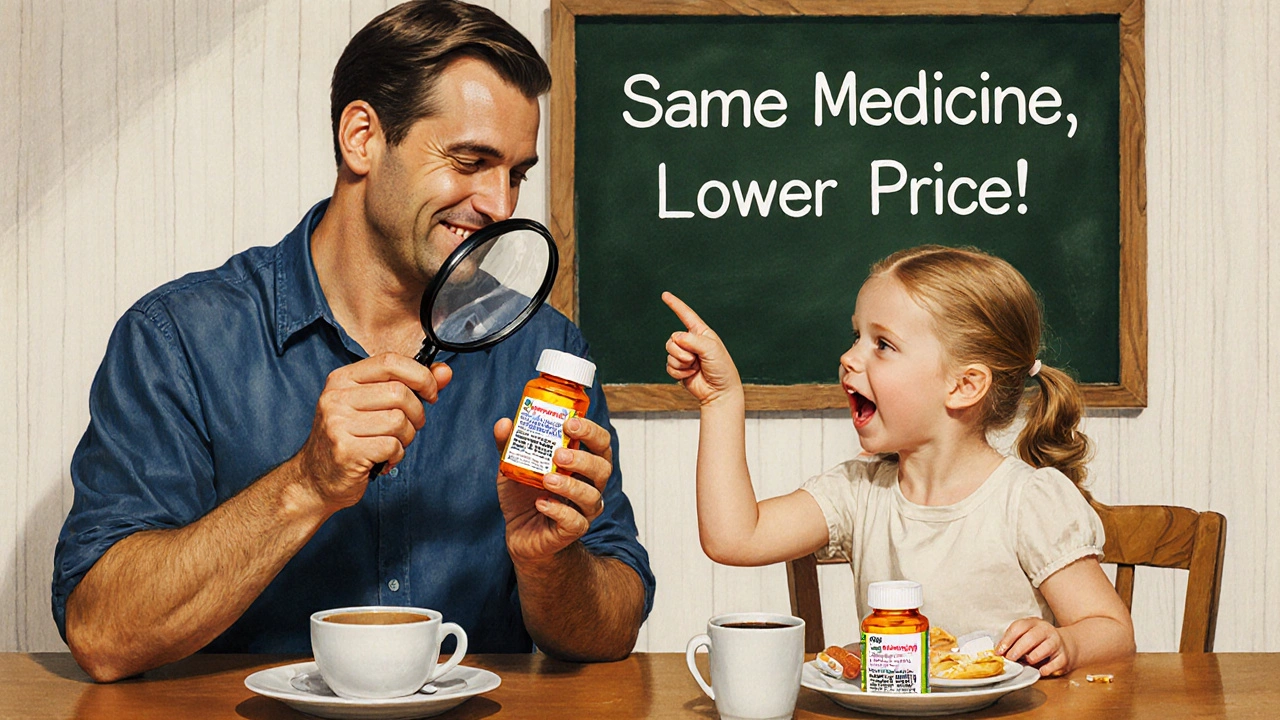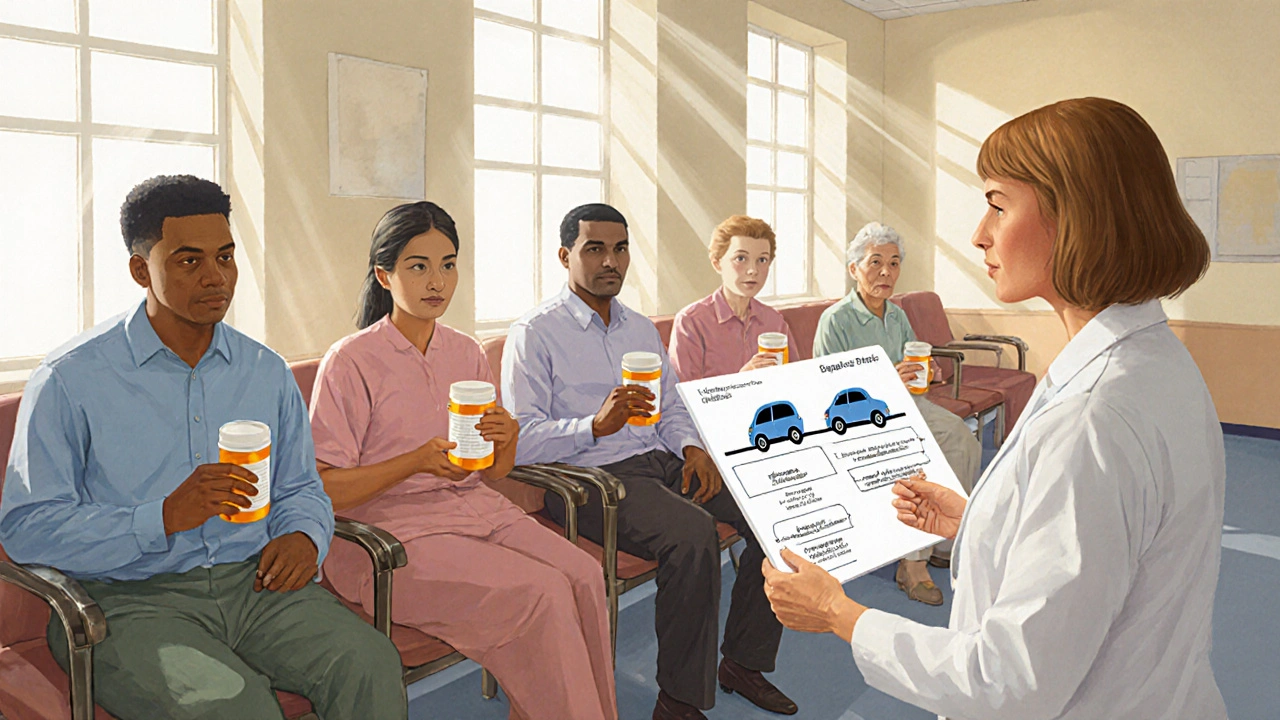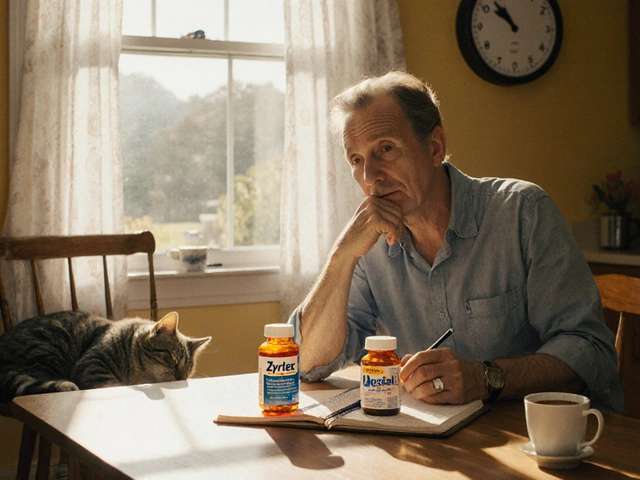Are generic drugs just copies? Let’s cut through the noise.
You’ve probably seen the price difference: a brand-name pill costs $60, and the generic version sits at $4. It’s tempting to wonder - is the cheaper one weaker? Less effective? Just a knockoff? The truth is more straightforward than the fear suggests. Generic drugs aren’t copies in the way a fake handbag is a copy. They’re scientifically proven equivalents, approved by the FDA to work the same way, in the same amount of time, with the same results.
Here’s what you need to know: every generic drug must contain the exact same active ingredient as its brand-name counterpart. If the brand-name drug is 20 mg of lisinopril, the generic is 20 mg of lisinopril. No less. No more. The FDA requires this. And it’s not just about the ingredient - the dosage form matters too. If the brand is a tablet, the generic must be a tablet. Same strength. Same route - whether it’s swallowed, injected, or applied topically.
How do we know generics work the same?
The FDA doesn’t just take a manufacturer’s word for it. Before a generic drug hits the shelf, it must pass a strict test called bioequivalence. This means scientists measure how quickly and how much of the drug enters your bloodstream compared to the brand-name version. The standard? The generic’s absorption rate must fall within 80% to 125% of the brand’s. That’s not a wide margin - it’s tight enough to ensure your body gets the same effect.
Think of it like two identical cars driving the same route. One’s a Honda Accord from 2023. The other’s a 2023 Honda Accord made by a different factory. Same engine. Same fuel efficiency. Same speed. The paint color? Different. The logo? Different. But under the hood? Identical. That’s what bioequivalence means. The FDA reviewed over 2,000 generic applications in 2022 and found that 99.2% of them contained the exact amount of active ingredient claimed on the label.
What’s different about generics?
While the active ingredient is identical, the rest of the pill isn’t. Generics can have different fillers, dyes, flavors, or preservatives - these are called inactive ingredients, or excipients. That’s why a generic version of your blood pressure pill might be blue instead of green, or have a different shape. These differences are allowed under trademark law, so generics don’t look like the brand-name drug. But they don’t affect how the medicine works.
Some people report feeling different on a generic - maybe a bit more tired, or a slight stomach upset. In most cases, this isn’t because the drug is weaker. It’s because their body is reacting to a new filler or coating. For example, someone allergic to a specific dye in a brand-name pill might have a reaction to the same dye in a generic version. Or someone sensitive to lactose might notice a change if the generic uses lactose as a binder and the brand doesn’t. These are rare, and pharmacists can help you find a version without the trigger ingredient.

When should you stick with the brand name?
There are exceptions. For drugs with a narrow therapeutic index (NTI), even tiny changes in blood levels can cause problems. These are medications where the difference between a therapeutic dose and a toxic dose is very small. Examples include warfarin (a blood thinner), levothyroxine (for thyroid conditions), and some epilepsy drugs like phenytoin.
For these, the FDA and most doctors recommend sticking with the same version - brand or generic - once you’ve found what works. Switching back and forth between different generics can cause small fluctuations in blood levels that might trigger side effects or reduce effectiveness. That’s why many patients on warfarin are advised to stay on one brand or one generic consistently. It’s not because generics are inferior - it’s because the margin for error is razor-thin.
Still, even for NTI drugs, studies show that 92% of substitutions work without issue when monitored properly. The problem isn’t the generic - it’s the switch. Consistency matters more than the label.
Why are generics so much cheaper?
Brand-name drugs cost a lot because the company spent years and hundreds of millions developing them. They ran clinical trials, patented the formula, and marketed the product. Once the patent expires - usually 20 years after filing - other companies can make the same drug. They don’t need to repeat the expensive trials. They just prove bioequivalence. That cuts costs dramatically.
The result? In 2023, the average generic drug cost $4.27 per prescription. The brand-name version? $61.85. That’s an 85% savings. In the U.S., generics make up 90% of all prescriptions but only 23% of total drug spending. That’s billions of dollars saved every year - money that goes back into patients’ pockets and keeps insurance premiums lower.
What do patients really think?
Surveys show most people are satisfied. On Drugs.com, 82% of users reported no difference in effectiveness between generic and brand-name drugs. A Kaiser Family Foundation survey found 89% of patients who received generics were happy with them. And among Medicare Part D users, 45% saved over $500 a year just by switching.
But myths persist. One in two people still believe generics contain only 20-80% of the active ingredient. That’s false. FDA testing shows generics contain 99.2% of the labeled active ingredient - the same as brands. Pharmacists spend an average of 3.2 minutes per prescription explaining this. That’s time they could be using to check for interactions or answer real safety questions.
Reddit threads and patient forums show most concerns come from people who switched from a brand to a generic and noticed a change - often minor, like a different pill shape or a new side effect. Rarely is it the drug itself. More often, it’s the inactive ingredients or the psychological effect of thinking, “This isn’t the real thing.”

Can pharmacists switch your prescription without asking?
In 49 U.S. states, yes. Pharmacists can substitute a generic for a brand-name drug unless the doctor writes “dispense as written” or “no substitution.” Mississippi is the only state that requires the prescriber to explicitly allow substitution. In 28 states, you can ask for the brand-name drug at the generic price if it’s considered therapeutically equivalent - a right many patients don’t know they have.
And here’s something important: if your doctor writes a prescription for a brand-name drug, but you’re on Medicare Part D, the plan will automatically fill it with the generic unless there’s a medical reason not to. That’s thanks to the 2022 Consolidated Appropriations Act, which aims to save $156 billion over 10 years.
What’s changing in the generic drug world?
The FDA is working to speed up approvals. In 2018, there were over 4,200 generic applications waiting. Now, thanks to the GDUFA IV program, they’re aiming to cut approval times to 10 months by 2027. They’re also focusing on harder-to-copy drugs - things like inhalers, injectables, and topical creams - where proving equivalence is more complex.
Biosimilars - the generic version of complex biologic drugs like Humira or Enbrel - are growing fast. They’re not exact copies (biologics are made from living cells, not chemicals), but they’re designed to work the same. As of 2023, less than 5% of biologics have biosimilar alternatives, but that’s expected to jump to 15% by 2027. That could mean huge savings for patients with autoimmune diseases, cancer, or diabetes.
Bottom line: Generics are safe, effective, and saving lives
Generic drugs aren’t copies. They’re scientifically validated, FDA-approved equivalents. For 96% of medications - from statins to antibiotics to blood pressure pills - they work just as well. The price difference isn’t a red flag. It’s proof the system is working.
Stick with the brand only if your doctor recommends it - usually for NTI drugs or if you’ve had a reaction to a specific generic. Otherwise, choose the generic. You’ll get the same result, save hundreds, and help keep healthcare affordable for everyone.
And if you’re ever unsure? Ask your pharmacist. They’re trained to explain the difference - and they’re the ones filling your prescription every day.
Are generic drugs less effective than brand-name drugs?
No. Generic drugs must meet the same FDA standards for effectiveness, safety, and quality as brand-name drugs. They contain the same active ingredient in the same strength and dosage form. The FDA requires them to prove bioequivalence - meaning they deliver the same amount of medicine into your bloodstream at the same rate as the brand-name version.
Why do generic drugs look different?
Generic drugs can look different because U.S. trademark laws require them to have a different shape, color, or marking than the brand-name version. This prevents confusion and protects the brand’s intellectual property. But the difference is only in the inactive ingredients - the fillers, dyes, or coatings - not the medicine itself.
Can generic drugs cause different side effects?
Sometimes, but not because the active ingredient is weaker. Side effects can come from inactive ingredients - like dyes, preservatives, or fillers - which may differ between brands and generics. For example, someone sensitive to lactose might react if a generic uses it as a binder. These reactions are rare, and pharmacists can help you find a version without the trigger ingredient.
Are generics safe for chronic conditions like high blood pressure or diabetes?
Yes. Generics are widely used and trusted for chronic conditions. Studies show over 98% of patients on generic statins, ACE inhibitors, or diabetes medications experience the same results as those on brand-name versions. The key is consistency - once you find a generic that works, stick with it unless your doctor advises otherwise.
Should I avoid generics for thyroid medication or blood thinners?
For drugs with a narrow therapeutic index - like levothyroxine or warfarin - doctors often recommend staying on the same version (brand or generic) once you’ve found one that works. Small changes in blood levels can matter here. But this isn’t because generics are unsafe - it’s because consistency matters more than the label. If you switch, your doctor will likely monitor your levels more closely.
Do pharmacists automatically switch my prescription to a generic?
In 49 U.S. states, yes - unless your doctor writes "do not substitute" on the prescription. Pharmacists are allowed to swap a brand-name drug for an FDA-approved generic to save you money. In some states, you can ask for the brand-name version at the generic price if it’s considered therapeutically equivalent.
Why do some people say generics don’t work for them?
Most often, it’s not the drug itself. It could be a reaction to a new inactive ingredient, or psychological bias - thinking a cheaper pill must be inferior. Rarely, a switch in a narrow therapeutic index drug can cause issues, but that’s why doctors monitor those cases closely. The vast majority of patients - over 80% - report no difference in effectiveness.
How long does it take for a generic to become available after a brand-name drug’s patent expires?
After a brand-name drug’s patent expires - typically 20 years after filing - other companies can apply to make a generic. The FDA approval process takes about 38 months on average. But patent litigation or exclusivity periods can delay entry. Some generics arrive within months, others take years. The FDA is working to reduce approval times to 10 months by 2027.






Comments
Chris Ashley
13/Nov/2025I switched my blood pressure med to generic and thought I was gonna drop dead. Turns out I just needed to stop staring at the pill like it was a snake. Now I save $50 a month and my BP is better than ever. 🤷♂️
kshitij pandey
13/Nov/2025In India, generics are life-saving. My dad takes cholesterol medicine and without generics, he couldn't afford it. The science is solid. Don't let fear stop you from saving money and staying healthy. 💪❤️
Brittany C
13/Nov/2025The bioequivalence threshold of 80–125% AUC and Cmax is statistically rigorous and aligns with ICH guidelines. The excipient variability is well-documented in pharmacokinetic literature-most perceived differences are placebo-driven or due to non-adherence. FDA’s GDUFA IV has significantly improved supply chain integrity for ANDAs.
Sean Evans
13/Nov/2025So let me get this straight-you’re telling me I’m supposed to trust some factory in India that makes my heart pills for $4? Meanwhile, my brand-name drug costs $60 but at least I know it’s not sitting in a warehouse with cockroaches and a guy named Raj who doesn’t speak English? 🤡 I’d rather pay extra and not die. #BrandTrust #NotBuyingIt
Anjan Patel
13/Nov/2025I switched to generic levothyroxine… and I felt like a zombie for three weeks. My doctor said ‘it’s fine’-but I know what I felt. Now I’m back on Synthroid and I’m alive again. People say ‘it’s the same’-but your body doesn’t lie. And if you think I’m just being dramatic, you haven’t lived with hypothyroidism. #GenericFail #TrustYourBody
Scarlett Walker
13/Nov/2025I used to be scared of generics too-until I started using them for my anxiety meds. No difference. Zero. I even showed my pill bottle to my mom and she didn’t believe me when I said it was the generic. Now I tell everyone: save your money, don’t stress. Your body won’t know the difference. 🌸
Hrudananda Rath
13/Nov/2025The commodification of pharmaceuticals represents a profound erosion of therapeutic integrity. To equate a bioequivalent generic with a meticulously engineered brand-name formulation is to misunderstand the very essence of pharmacological precision. The FDA’s 80–125% window is not a standard-it is a compromise. And compromise, in medicine, is negligence.
Brian Bell
13/Nov/2025I’ve been on generic statins for 5 years. No side effects. Saved over $2k. My doctor said ‘go generic’ and I did. Best decision ever. Also, the pill is blue now. So what? 😎
Nathan Hsu
13/Nov/2025I just want to say, as someone who’s worked in pharmacy for 17 years, that the idea that generics are ‘less effective’ is not just wrong-it’s dangerously misleading. The FDA tests every batch. Every. Single. One. And if you think your doctor doesn’t know this, you’re wrong. They’re not trying to save you money-they’re trying to save your life, one prescription at a time.
Ashley Durance
13/Nov/2025You’re all missing the point. The real issue isn’t efficacy-it’s consistency. If you’re on warfarin and your pharmacist switches you to a different generic every month, you’re playing Russian roulette with your INR. And no, ‘it’s the same’ doesn’t cut it when your blood starts clotting. The system is broken, and you’re all just ignoring it because it’s cheaper. #PharmaSystemFail